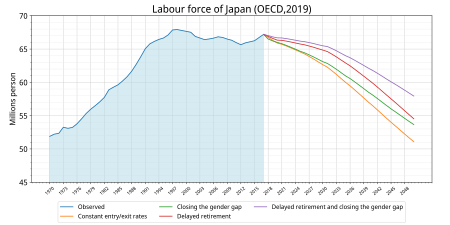This article has multiple issues. Please help improve it or discuss these issues on the talk page. (Learn how and when to remove these messages)
|


The labor force in Japan numbered 65.9 million people in 2010, which was 59.6% of the population of 15 years old and older, and amongst them, 62.57 million people were employed, whereas 3.34 million people were unemployed which made the unemployment rate 5.1%.[3] The structure of Japan's labor market experienced gradual change in the late 1980s and continued this trend throughout the 1990s. The structure of the labor market is affected by: 1) shrinking population, 2) replacement of postwar baby boom generation, 3) increasing numbers of women in the labor force, and 4) workers' rising education level. Also, an increase in the number of foreign nationals in the labor force is foreseen.
As of 2019, Japan's unemployment rate was the lowest in the G7[2] Its employment rate for the working-age population (15-64) was the highest in the G7.[2]
By 2021 the size of the labor force changed to 68.60 million, a decrease of 0.08 million from the previous year. Viewing by sex, the male labor force was 38.03 million, a decrease of 0.20 million, and the female labor force was 30.57 million, an increase of 0.13 million. The % of employed people increased to 62.1% from that of 59.6% in 2010. Breaking it by sex, the ratio of employed males was 71.3%, a decrease of 0.1 percent points from the previous year, and the ratio of the labor force of females was 53.5%, an increase of 0.3 percent points.[4]
In 2021, the labor force aged 15-64 was 59.31 million, a decrease of 0.15 million. Viewing by sex, the male labor force aged 15-64 was 32.52 million, a decrease of 0.20 million, and the female labor force aged 15-64 was 26.79 million, an increase of 0.06 million.
The labor force participation rate of those aged 15-64 was 80.1%, an increase of 0.5 percent points. Viewing by sex, the participation rate of males aged 15-64 was 86.7%, an increase of 0.2 percent points.[4]
- ^ OECD Economic Surveys: Japan 2019, OECD Economic Surveys: Japan, OECD, 2019, doi:10.1787/fd63f374-en, ISBN 9789264610613, S2CID 242830940
- ^ a b c Cite error: The named reference
OECDLFwas invoked but never defined (see the help page). - ^ Japan MIC Statistic Bureau. "Summary of the 2010 Yearly Average Results". Retrieved 23 July 2022.
- ^ a b "Statistics by Theme". Portal Site of Official Statistics of Japan. Retrieved 2022-07-23.
 Text was copied from this source, which is available under a Creative Commons Attribution 4.0 International License.
Text was copied from this source, which is available under a Creative Commons Attribution 4.0 International License.